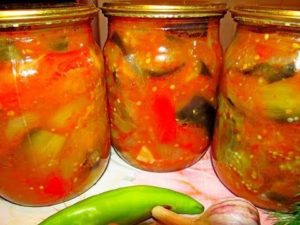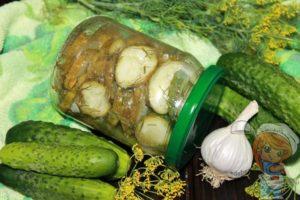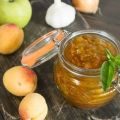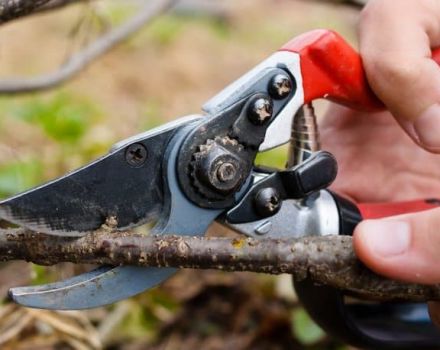A step-by-step recipe for making tomato sauce with basil for the winter
Tomato sauce with basil prepared for the winter will become an indispensable addition to pizza, meat and fish dishes, stewed and fried vegetables, as well as pasta. Spicy and aromatic, it will advantageously emphasize the taste of any treat. The proposed recipes and recommendations will allow you to independently create a delicious alternative to store-bought sauces and ketchups.
Features of the preparation of tomato sauce with basil
In winter, the need for vitamins is especially acute, but it is problematic to buy fresh vegetables and fruits. Cooking tasty and healthy preserves is the best solution to the problem. Strict adherence to the recipe of tomato sauce with basil and the technology of its preparation allows you to fully preserve the vitamin and mineral set inherent in fresh juicy vegetables.
To make this Italian sauce as healthy and tasty as possible, you must:
- choose the highest quality fresh and ripe vegetables without nitrates and other harmful substances (preferably grown on your own plot or bought in trusted places);
- use exclusively sterilized containers for preservation;
- follow the recipe exactly;
- additionally use citric acid or vinegar (apple or tartaric can be used) to increase the shelf life of the prepared sauce;
- to preserve the maximum useful properties of vegetables, do not subject them to very long heat treatment.
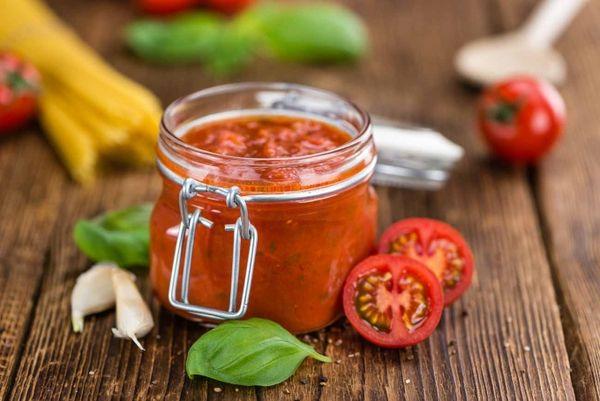
Required ingredients
For the classic Italian tomato and basil sauce, prepare the following ingredients:
- 3.5 kilograms of tomatoes;
- a few sprigs of basil (fresh or dried);
- 2 medium-sized dense onions;
- 2 large ripe bell peppers;
- 25 black peppercorns;
- 10 peas of allspice;
- 1 head of medium size garlic;
- 4 tbsp. l. granulated sugar;
- 1 tsp table or sea salt;
- 50 ml 9% table vinegar;
- 4 tbsp. l. refined vegetable oil.
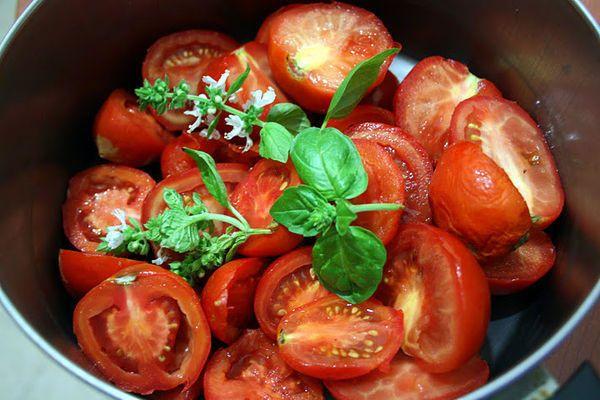
Choosing and preparing tomatoes
The selection of tomatoes must be taken responsibly, because the taste, quality and safety of the finished sauce depend on it.
Ripe, juicy and fleshy fruits with a sweetish taste are ideal for these purposes.
When buying, you must carefully inspect each fruit for damage and signs of decay.
Further, the selected fruits should be prepared properly:
- Remove green tails and wash thoroughly.
- Make light cruciform cuts on each tomato.
- Keep in boiling water for 2-3 minutes - this procedure will facilitate the subsequent removal of the skin.
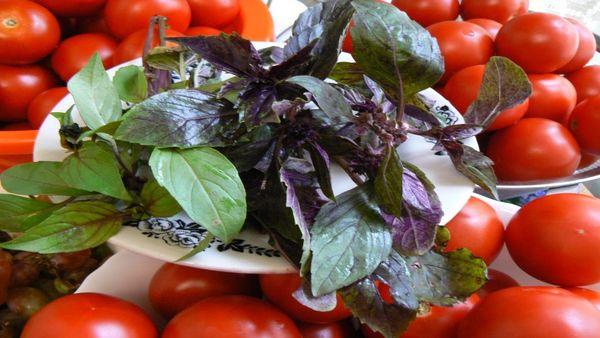
How to prepare containers correctly?
Glass jars do not emit harmful substances when exposed to high temperatures, therefore, they are best suited for preserving tomato-basil sauce. In addition, in such a container, the aroma and taste of the finished product are ideally preserved. There should be no chips or cracks on the glass.
Before starting preparation, the jars must be washed with water and baking soda, and then sterilized in any convenient way:
- Fill a large saucepan with water. Put on a metal sieve on top, on which set the cans with the neck down. When the water boils, steam is formed, which penetrates into the inside of each jar and disinfects. The procedure should last 15 minutes, after which the containers in the same position should be placed on a clean towel made of natural fabric.
- Place a washed, but not wiped glass container in the oven and warm up at a temperature of +160 degrees until all the droplets are dry.
- Pour water (no more than 1 centimeter in height) into the bottom of the can and place it in the microwave for 5 minutes, having previously set the power to 700 W. As the water boils, steam forms, which sterilizes the containers.
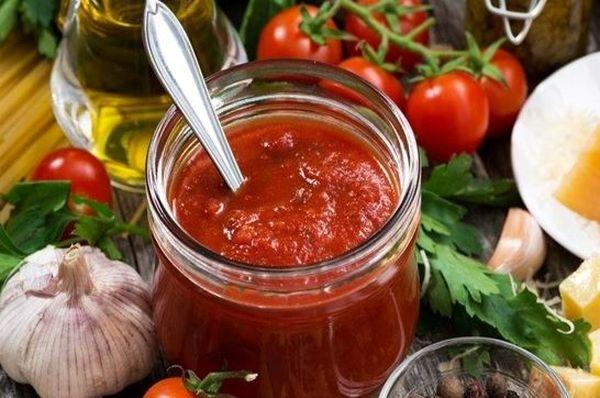
Container closures also require sterilization. To do this, they must be boiled for 10-15 minutes.
How to make tomato basil sauce for the winter?
A universal recipe for making tomato sauce with basil for the winter is affordable and easy to perform. This requires:
- Put the pre-blanched and peeled tomatoes into a blender bowl. Cut the largest specimens into slices.
- Add basil sprigs to the tomatoes and grind.
- Transfer the resulting puree into a thick-bottomed and thick-walled saucepan, cover and simmer for half an hour over low heat. All this time, observe the vegetable mass so that it does not burn, otherwise the taste of the sauce will be hopelessly spoiled.
- After 30 minutes, remove the lid from the container and add spices, as well as sugar and salt. Further, while stirring, continue to boil the mass a little more until the required consistency.
- Add vinegar and vegetable oil.
- Stir, remove a sample and, if the taste is completely satisfied, spread the sauce into sterilized jars and roll up.
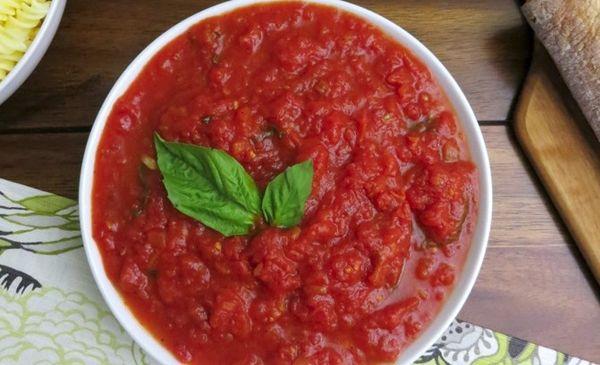
There is another cooking option. In this case, you will need:
- Heat vegetable oil in a skillet.
- Grind allspice and black peppercorns in a mortar, add to the oil and fry for two minutes.
- Cut the peeled cloves of garlic into pieces and add to the pepper-oil mixture. Stirring constantly, continue to fry for another three minutes.
- Peel the onions and cut into half rings. Add to the rest of the ingredients and sauté for five minutes. As a result, the onion should be slightly softened, but not fried.
- Take a deep, roomy saucepan and transfer the resulting mass into it.
- Add sliced Bulgarian pepper and sauté for about five minutes.
- Rub the tomatoes on a grater and add them to the pan with the rest of the ingredients.
- Salt, add sugar and boil for half an hour at the lowest heat level, constantly stirring the vegetable mass.
- When the liquid has evaporated and the sauce thickens, add the chopped basil sprigs to it and continue to cook for 5 minutes.
- At the end of the cooking process, add vinegar, mix everything thoroughly again and remove from heat after two minutes.
- After cooling the mass, pass it through a blender for a few seconds. In this case, you do not need to achieve a uniform consistency.
- Boil again, arrange in glass jars and tighten with sealed lids.
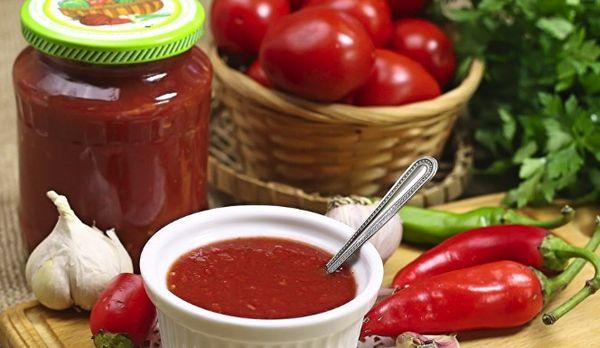
Sauce storage rules
Canned sauce is well stored in basements, closets or other utility rooms with low air temperatures. If the content of vinegar or other preservatives is minimal, the jars should be refrigerated.
